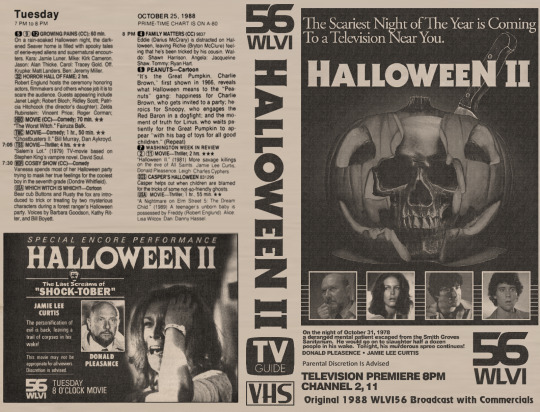#Newspaper Advertising
Explore tagged Tumblr posts
Text










Halloween II newspaper ads
#horror#horror movies#horror movie#movie#movies#newspaper ads#newspaper advertising#newspapers#newspaper#newspaper advertisements#john carpenter#Halloween ii#Halloween 2#halloween ii 1981#halloween 2 1981#michael myers#dick warlock#jamie lee curtis#laurie strode#donald pleasence#sam loomis#dr loomis#dr Sam Loomis#80s#80s horror#80s horror movie#80s horror movies#vintage advertisement#vintage horror#vintage
288 notes
·
View notes
Text

#pearl jam#advertisement#1990s#alternative rock#classic rock#grunge#eddie vedder#jeff ament#mike mccready#stone gossard#dave abbruzzese#newspaper advertising#vs tour#edmonton#alberta#canada#1993#hard rock
23 notes
·
View notes
Text

#art#artists on tumblr#weirdcore aesthetic#weirdcore#halloweencore#halloween#supernatural#ghosts#spirits#oddcore#strangecore#surrealcore#newspaper advertising#advertisement#ad core#old commercials#commercial core#parody ad#newspaper ads#2010s nostalgia#nostalgiacore#nostalgic#nostalgia#gothic
16 notes
·
View notes
Text
1925 Chicago Defender ad for a Papa Charlie Jackson 78 on the Paramount label.

#20th century#retro#newspaper advertising#blues#paramount#papa Charlie Jackson#phonograph record#illustration art#Chicago Defender#musical instruments
7 notes
·
View notes
Text

Halloween ads in a local newspaper, October 23, 1996, Massachusetts, USA.
#halloween#newspaper#ads#advertisement#advertising#1996#october#clip art#newspaper ads#newspaper advertising#stoneham#woburn#massachusetts#90's#90s
7 notes
·
View notes
Text

20 notes
·
View notes
Text

#judas priest#newspaper advertising#1980s#heavy metal#classic rock#world vengeance tour#vancouver#british columbia#canada#1982
7 notes
·
View notes
Text

WARNING! this is an ad :3
a snippet from issue 2 of the blugg newspaper
#blugg#newspaper#graphic design#print#illustration#zine#artists on tumblr#graphic art#adobe illustrator#typography#designinspiration#advertising#newspaper advertising
4 notes
·
View notes
Text

Mickey Mouse earns top billing. Come for the cartoon, stay for the feature.
"Motion Picture Herald," February 23, 1932.
10 notes
·
View notes
Text
Redefining Newspaper Advertising: A Look at Modern Ad Agencies

#ad in newspaper#advertise in newspaper#advertising in paper#book ad in newspaper#newspaper ad booking#newspaper advertisement#newspaper advertising#book newspaper ad online#online newspaper ad booking#give advertisement in newspaper#newspaper ad type
0 notes
Text
0 notes
Text


Starts Today!
#horror#horror movies#horror movie#movie#movies#newspaper#newspaper advertising#newspaper ads#newspapers#vintage advertisement#vintage horror#vintage#vintage newspapers#vintage newspaper#the stuff 1985#the stuff#silver bullet#silver bullet 1985#Godzilla#Godzilla 1985#Ghoulies#Ghoulies 1985
147 notes
·
View notes
Text
Measuring the Effectiveness of Newspaper Advertising: Metrics and Insights
Newspaper advertising has been a cornerstone of marketing strategies for decades. While digital media has gained significant traction in recent years, newspapers continue to offer a unique advantage for brands looking to reach specific demographics, whether local or national. However, measuring the effectiveness of newspaper advertising remains a challenge for many marketers. Understanding the right metrics and insights can help determine if a newspaper campaign is delivering the desired results and how to optimize future efforts.
In this article, we will explore the various ways to measure the effectiveness of newspaper advertising, focusing on key metrics that can provide valuable insights into the performance of print ads.
The Role of Newspaper Advertising
Newspaper advertising provides a tangible and trusted platform for brands to reach their audience. Print ads are typically placed in daily or weekly publications, offering businesses an opportunity to showcase their products or services to a wide range of readers. Newspapers have a broad audience that spans across multiple age groups, income levels, and interests. This allows for targeted advertising that can be tailored to specific sections, such as business, lifestyle, or local news. Although the industry has faced challenges due to the rise of online news and social media, newspaper advertising still holds significant weight for many industries, especially in reaching older demographics, local markets, and niche audiences.
Key Metrics to Measure the Effectiveness of Newspaper Advertising
Reach and Circulation: One of the most basic metrics for assessing the effectiveness of newspaper advertising is reach and circulation. Reach refers to the number of readers who are exposed to an ad, while circulation is the total number of copies of the newspaper that are distributed. The larger the circulation and reach, the more potential impressions your ad will generate. By considering the circulation figures of the publication you’re advertising in, you can estimate the overall exposure of your ad. Many newspapers publish their circulation numbers, allowing businesses to assess the scope of their ad’s visibility. However, it’s essential to also consider the actual readership, as not all distributed copies are read.
Audience Demographics: Understanding the demographics of the newspaper’s readership is crucial for evaluating whether your ad is reaching the right target audience. Newspapers often provide information about their audience’s age, gender, income, and interests, which can help determine if the ad placement aligns with your marketing goals. For instance, if you are targeting a younger, tech-savvy demographic, an ad in a local newspaper with a predominantly older audience may not yield the desired results. Conversely, if your brand caters to a more mature, community-focused audience, a regional or national newspaper could be an ideal choice. Many publications offer audience reports and readership surveys, which provide insights into the profile of their readers. These insights allow marketers to make more informed decisions regarding ad placements.
Ad Placement and Position: The placement of an ad within a newspaper plays a significant role in its effectiveness. Ads placed in prime positions, such as the front page, back page, or near relevant editorial content, typically garner more attention and engagement than those placed in less prominent sections. Understanding where your ad is placed can help you assess its potential impact. For instance, an ad in the business section of a financial newspaper may resonate more with professionals than an ad in the entertainment section. Measuring the performance of ads in different sections and placements can help optimize future campaigns.
Ad Recall and Brand Recognition: Ad recall is a measure of how well readers remember the ad after seeing it. This can be assessed through surveys, focus groups, or direct consumer feedback. Brand recognition, on the other hand, refers to how well a consumer can identify your brand after encountering the ad. To measure ad recall, marketers often conduct post-campaign surveys asking readers if they recall seeing the ad and whether it influenced their perception of the brand. These insights can provide valuable feedback on the effectiveness of the messaging and design. For instance, if readers recall an ad but cannot remember the brand or product being advertised, it indicates a need to refine the messaging or visual elements in future campaigns.
Response Rates and Call-to-Action (CTA) Metrics: A critical way to measure the success of newspaper advertising is by tracking the response rates. The response rate is the percentage of readers who take action after seeing an ad, whether it’s visiting a website, making a purchase, or calling a customer service line. To track this metric, it’s essential to include a clear call-to-action (CTA) in the ad. Common CTAs for newspaper ads include special offer codes, phone numbers, website URLs, or invitations to events. By using unique tracking codes for each campaign or offering a discount that is exclusive to readers of a particular newspaper, businesses can determine how many people acted on the ad. For instance, if a newspaper ad promotes a limited-time discount, tracking how many customers use the promotional code can provide valuable data on the effectiveness of the ad.
Sales Lift and ROI (Return on Investment): Ultimately, the effectiveness of any advertising campaign is determined by its impact on sales and return on investment (ROI). After a newspaper ad campaign has run, businesses should assess whether there has been a noticeable lift in sales or inquiries that can be attributed to the ad. To measure this, businesses can compare sales figures before and after the campaign period. ROI can be calculated by dividing the additional revenue generated from the campaign by the cost of the ad placement. A high ROI indicates that the newspaper ad was successful in driving sales, while a low ROI suggests that adjustments may be necessary in future campaigns.
Customer Feedback and Sentiment: One of the more qualitative ways to assess the effectiveness of newspaper advertising is through customer feedback. By monitoring online reviews, social media mentions, or direct feedback from customers, businesses can gauge how readers perceive the ad. Positive sentiment around the ad, especially if it aligns with the brand’s values or messaging, suggests that the ad is resonating with the audience. Negative feedback, on the other hand, may indicate that the ad missed the mark or failed to connect with readers.
Conclusion
Measuring the effectiveness of newspaper advertising involves a combination of quantitative and qualitative metrics, ranging from circulation and reach to more specific data like response rates and sales lifts. By analyzing these metrics, businesses can gain valuable insights into how their print campaigns are performing and identify areas for improvement. For brands looking to get the most out of their newspaper advertising efforts, working with an experienced newspaper advertising agency can provide the expertise and data analysis needed to create and refine highly effective print campaigns. With the right metrics and insights, businesses can optimize their newspaper advertising to maximize brand exposure and drive better results.
0 notes
Text

#ad core#commercial#commercialcore#newspaper ads#newspaper advertising#halloween#fall aesthetic#fall#autumn#weirdcore aesthetic#weirdcore#late 2000s#commercial core#old commercials#nostalgiacore#2010s nostalgia#halloweencore
4 notes
·
View notes
Text
1928 newspaper ad

1 note
·
View note